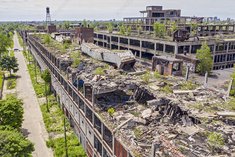Featured Quizzes
User Quizzes
Create Quiz
Data and Charts
Badges and Games
About JetPunk
JetPunk Shop
Dark Mode

U.S. Cities That Lost Half Their Population
Cities that at one point declined by at least 50%, after having reached at least 50,000 people.
The column headings are shortened to fit on mobile. They are: Peak Population / Peak Year / Lowest Population Since Peak / Low Year / % Decline / 2020 Population/ City
The column headings are shortened to fit on mobile. They are: Peak Population / Peak Year / Lowest Population Since Peak / Low Year / % Decline / 2020 Population/ City
Population numbers are only from an official census. No intermittent year wild guesses.
Some cities' old boundaries did lose over 50%, but they had annexed land and thus escaped this statistical fate.
Rate:
Last updated: October 28, 2022
You have not attempted this quiz yet.
More quiz info >>
| First submitted | October 14, 2022 |
| Times taken | 63 |
| Average score | 50.0% | Report this quiz | Report |
6:00
Enter answer here
0
/ 18 guessed
Time Used
00:00
Best Time
00:00
The quiz is paused. You have remaining.
Scoring
You scored / = %
This beats or equals
% of test takers
also scored 100%
The average score is
Your high score is
Your fastest time is
Keep scrolling down for answers and more stats ...
|
New and Popular
Save Your Progress
Census Quizzes
Quiz series by IsleAuHaulte
Copyright H Brothers Inc, 2008–2024
Contact Us | Go To Top | View Mobile Site

1900.......287,104.......+18.6%
1910.......339,075.......+18.1%
1920.......387,219.......+14.2%
1930.......458,762.......+18.5%
1940.......494,537.........+7.8%
1950.......570,445.......+15.3%
1960.......627,525.......+10.0%
1970.......593,471.........−5.4%
1980.......557,515.........−6.1%
1990.......496,938.......−10.9%
2000.......484,674.........−2.5%
2010.......343,829.......−29.1%
2020.......383,997.......+11.7%
If the county in whole merged with Pittsburgh, it would have 1,250,578 people in 730 mi² (1,900 km²), making it the 2nd largest city physically in the U.S. outside of Alaska, just behind Jacksonville's 747 mi².
The entire area has plummeted, with Allegheny County having 1,628,587 people in 1960, a 23.2% decrease. That's a modest increase of 27,000 from the nadir in 2010.
It's too bad; it's actually a very beautiful setting for a city.
Despite a multitude of flat-out lies by modern day gold diggers of Western states, the largest ghost towns in the U.S. are by far and away east of the Rockies. Many, like Picher and the famous subterranean inferno of Centralia, Pennsylvania, are former towns that have severe dangers of cave-ins and toxic waste. Niagara Falls' Love Canal toxic disaster site would have brought that settlement completely down were it not for the cash cow of the falls themselves.
one example is Cairo, Illinois, a city on the Ohio River that went from around 16,000 people in the mid 20th century to only 1,700 people in the 2020 census, and people are still leaving by the hundreds.